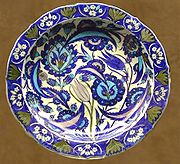
Fritware
Encyclopedia

Islamic stone-paste
Islamic stone-paste, also called fritware and quartz frit, is a ceramic material which seems to have been first manufactured in Iraq in the 9th century...
, is a type of pottery
Pottery
Pottery is the material from which the potteryware is made, of which major types include earthenware, stoneware and porcelain. The place where such wares are made is also called a pottery . Pottery also refers to the art or craft of the potter or the manufacture of pottery...
in which frit
Frit
Frit is a ceramic composition that has been fused in a special fusing oven, quenched to form a glass, and granulated. Frits form an important part of the batches used in compounding enamels and ceramic glazes; the purpose of this pre-fusion is to render any soluble and/or toxic components insoluble...
is added to clay
Clay
Clay is a general term including many combinations of one or more clay minerals with traces of metal oxides and organic matter. Geologic clay deposits are mostly composed of phyllosilicate minerals containing variable amounts of water trapped in the mineral structure.- Formation :Clay minerals...
to reduce its fusion temperature. As a result, the mixture can be fired at a lower temperature than clay alone.
Fritware refers to a type of pottery which was first developed in the Near East
Near East
The Near East is a geographical term that covers different countries for geographers, archeologists, and historians, on the one hand, and for political scientists, economists, and journalists, on the other...
, where production is dated to the late first millennium AD through to the second millennium AD. Frit was a significant ingredient. A recipe for 'fritware' dating to c. 1300 AD written by Abu’l Qasim reports that the ratio of quartz to 'frit-glass' to white clay is 10:1:1. This type of pottery has also been referred to as "stonepaste" and "faience" among other names. A ninth century corpus of 'proto-stonepaste' from Baghdad
Baghdad
Baghdad is the capital of Iraq, as well as the coterminous Baghdad Governorate. The population of Baghdad in 2011 is approximately 7,216,040...
has "relict glass fragments" in its fabric. The glass is alkali-lime-lead-silica and, when the paste was fired or cooled, wollastonite
Wollastonite
Wollastonite is a calcium inosilicate mineral that may contain small amounts of iron, magnesium, and manganese substituting for calcium. It is usually white. It forms when impure limestone or dolostone is subjected to high temperature and pressure sometimes in the presence of silica-bearing fluids...
and diopside
Diopside
Diopside is a monoclinic pyroxene mineral with composition MgCaSi2O6. It forms complete solid solution series with hedenbergite and augite, and partial solid solutions with orthopyroxene and pigeonite. It forms variably colored, but typically dull green crystals in the monoclinic prismatic class...
crystals formed within the glass fragments. The lack of "inclusions of crushed pottery" suggests these fragments did not come from a glaze. The reason for their addition would have been to release alkali into the matrix on firing, which would "accelerate vitrification at a relatively low firing temperature, and thus increase the hardness and density of the [ceramic] body." Whether these "relict glass fragments" are actually 'frit' in the more ancient sense remains to be seen.
Iznik pottery
Iznik pottery
İznik pottery, named after the town in western Anatolia where it was made, is highly decorated ceramics that was produced between the late 15th and 17th centuries....
was produced in Ottoman Turkey
Ottoman Empire
The Ottoman EmpireIt was usually referred to as the "Ottoman Empire", the "Turkish Empire", the "Ottoman Caliphate" or more commonly "Turkey" by its contemporaries...
as early as the 15th century AD. It consists of a body, slip, and glaze, where the body and glaze are 'quartz-frit'. The 'frits' in both cases "are unusual in that they contain lead oxide as well as soda"; the lead oxide would help reduce the thermal expansion coefficient of the ceramic. Microscopic analysis reveals that the material that has been labeled 'frit' is 'interstitial glass' which serves to connect the quartz particles. The glass was added as frit and that the interstitial glass formed on firing.

